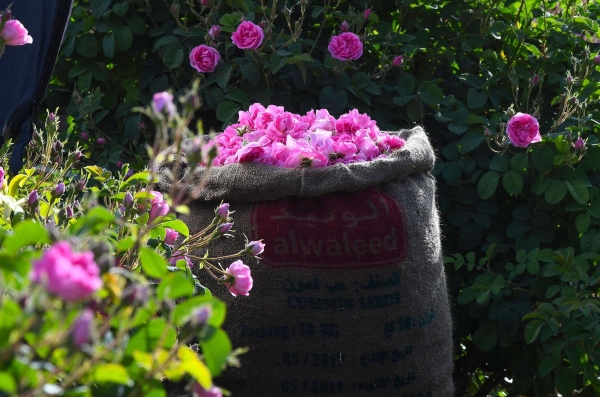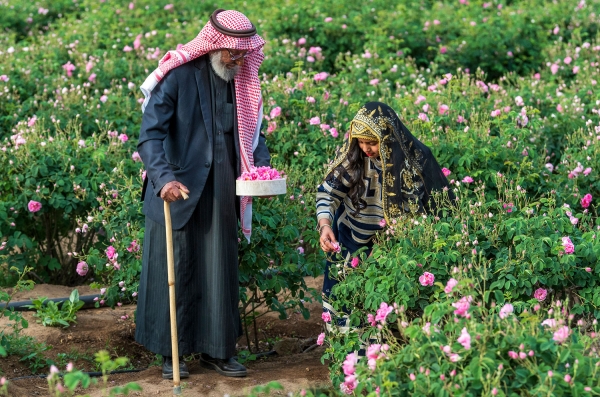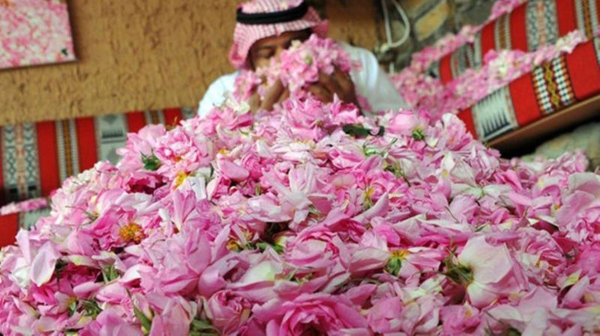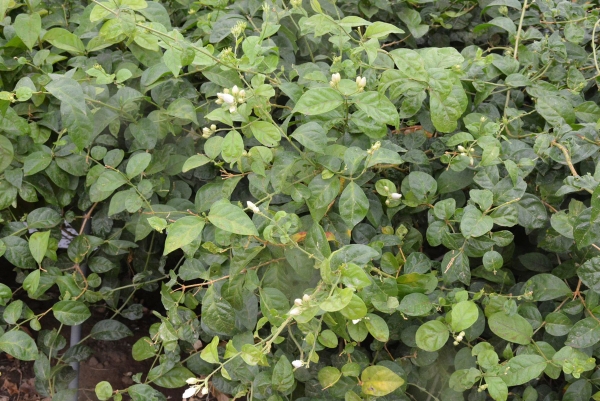




The Cultivation of Aromatic Plants in the Kingdom of Saudi Arabia refers to a type of organized cultivation widely found in several provinces and governorates of the Kingdom. These regions include Jazan Province whose farms annually produce around eight hundred t of aromatic plants. Roses and other aromatic plants are cultivated in Taif Governorate and Aseer Province for the extraction of volatile and essential oils for commercial purposes. Yarrows are among the most notable aromatic plant varieties cultivated in the Northern Borders Province.
Aromatic plants are used within communities for personal decoration and space ornamentation. They are also used for the production of essential oils, perfumes, incense, cosmetics, soap, and pharmaceuticals.
Aromatic plants in Saudi Arabia
Several varieties of aromatic plants are cultivated in Saudi Arabia, such as the tephrosia nubica, rue, wormwood, and lavender.
- Tephrosia nubica: It is an aromatic plant with dusty white leaves. It is a perennial shrub with a scent similar to the marjoram of al-Madinah al-Munawwarah. It is suitable for cultivation in Saudi Arabia's regions with a moderate climate.
- Rue: It is distinguished by a pleasant aroma. It bears green-bluish leaves and yellow flowers. It is classified as a herbaceous shrub. It is suitable for cultivation in Harrat al-Sarat, Tihamah, and Saudi Arabia's plains with a moderate climate in the Red Sea area.
- Wormwood: It is distinguished by its thyme-like pleasant aroma. It bears light purple bell-shaped flowers. It is suitable for cultivation in areas with moderate and cool climates.
- Lavender: It is an aromatic plant distinguished by a rosemary-like aroma. It bears light purple flowers that produce delicious honey upon pollination. It is suitable for cultivation in areas with moderate and cool climates.
These aromatic plants are suitable for the ornamentation of entrances to cities, squares, streets, and backyards. They can also be used for garden landscaping.
Aromatic plants in Jazan Province
The farms of Jazan Province annually produce around eight hundred t of aromatic plants and export their products to markets. Cultivativated varieties include jasmine, pandanus tectorius, wormwood, narcissus, cladrastis, lavender, mugworts, halimolobos, chrysanthemum, and ochthochloa.
It is common to wear a headband made of aromatic plants in Jazan Province, where these handbands come in a variety of shapes, colors, and sizes. In this respect, aromatic plats are arranged to ornate the heads of men, while they are wrapped around the necks of women in an aesthetic manner. They are also placed on the bride's hair, reflecting both aesthetics and joy. This practice is a folk heritage passed down from one generation to another.
The trade of aromatic plants thrives in Jazan Province. In fact, there are dedicated places for the sale of ornamental aromatic plants that are in high demand during the season of holidays and special occasions, where these plants are intrinsically linked to the province's identity.
Aromatic plants are also a valuable economic resource that generates financial revenues. In fact, they are used for the production of incense and perfumes, ultimately leading the inhabitants of the province, already renowned for its aromatic plant production, to engage in this industry.
Saudi women in Jazan Province own shops where they sell customized incense and perfumes inspired by their personal skills and experience. Some of them view festivals and weddings as opportunities to sell these aromatic products, while others establish their businesses from home or on social media platforms.
Aromatic plants in the Northern Borders Province
The wild forests of the Northern Borders Province are home to several aromatic plants, including wormwood, teucrium polium, yarrows, asteriscus graveolens, and mugworts, among other plants usually found in the bottomlands. The wild forests of the province also comprise seasonal aromatic plants, such as clover, garden cress, thyme, lavender, nettle leaf, Pulicaria, and roemeria.
Yarrows are among the most notable aromatic plants cultivated in the Northern Borders Province. It is an aromatic shrub whose branches bear clusters of appealing yellow flowers. Yarrows contribute to combatting desertification increasing vegetation, stabilizing the soil, enhancing biodiversity, and improving the environment.
The shrub is found in most areas of the province, specifically in valleys and bottomlands with clay soils. It is a strong aromatic plant whose leaves are used to make a beverage similar to tea. Yarrow honey is one of the natural types of honey produced in the province. It is mostly used in houses, where it spreads a pleasant aroma.
Aromatic plants in al-Jawf Province
Al-Jawf Province houses several wild aromatic plants found in desert and wild areas. These plants grow during various seasons of the year, namely during spring when aromatic lavender flowers bloom along with several other wild aromatic plants and flowers, such as asteriscus graveolens and chrysanthemum.
The province invests its aromatic plants in several manufacturing industries, where they are used for making perfumes, soap, and personal care products. The Truffle and Aromatic Plants Festival was held in Sikaka City, where several aromatic plant-based products were showcased.
Aromatic plants in Taif Governorate
Aromatic plants grow on al-Shafa mountain peak in Taif Governorate as well as on its highlands covered with dense forests of juniper trees and aromatic plants such as rose, lavender, jasmine, and basil.
Roses are among the notable aromatic plants cultivated in Taif, where its plantations are spread throughout the governorates. Roses are characterized by their colors and aroma. They are used for extracting perfumes and making other rose-based products. Rose harvesting is based upon three stages: rose harvesting before dawn, rose weighing to determine the harvested quantity, and rose distillation.
Aromatic plants in Aseer Province
Aromatic plants have maintained their historical position and purchase value in Aseer Province, renowned for its abundance and diversity of mountain and wildflowers with pleasant aromas, upon noting that this dense presence of plants is due to the province's soil fertility and rainfall.
Muhayil Aseer Governorate is known for the cultivation of aromatic plants and their exports to the various regions of Saudi Arabia. These plants include bulrush, rue, basil, wormwood, shorea, amaranth sanicle, and flacourtia, among other plants known for their pleasant aroma and attractive colors.
Aromatic plants are one of the main features of costumes worn by the men of Tihamah in Aseer Province. In fact, a decades-old tradition has seen men wear headbands made of basil, bulrush, wormwood, and pandanus tectorius, ultimately forming a tradition passed down from one generation to another.
Efforts of the Ministry of Environment, Water, and Agriculture (MEWA) in the field of aromatic plant cultivation
Stemming from the widespread availability of jasmine in Jazan Province and the attention and care attached by the local community thereto, the Ministry of Environment, Water, and Agriculture (MEWA) is deploying its efforts to establish six cities specialized in the cultivation of jasmine in the province, ultimately contributing to maintaining its sustainability and preserving its availability.
The Association of Jasmine and Aromatic Plants
The Association of Jasmine and Aromatic Plants was established to contribute to the marketing and export of jasmine. The association seeks to support the farmers of jasmine and aromatic plants, supply agricultural materials, such as seedlings, seeds, fertilizers, and agricultural equipment, qualify farmers to obtain the certificates required for product export, and organize marketing and agricultural festivals celebrating jasmine.
The Jasmine and Aromatic Plants Festival
The Jasmine and Aromatic Plants Festival, annually held in Jazan Province, aims to introduce jasmine, highlight its intrinsic reflection of the province's identity, and offer opportunities to investors, farmers, and those interested in the cultivation of jasmine.
Production of essential oils in Saudi Arabia
The locally produced natural rose oil, extracted from aromatic plants, is used for making pharmaceuticals. Essential oils are classified per use, as follows:
- Oils used for medical or pharmaceutical purposes, such as thyme volatile oil, used as as an anti-inflammatory or antiseptic.
- Oils used for making cosmetics and some types of soaps and perfumes.
- Oils used in the food industry, where they are used to enhance flavors or preserve food and beverages.
Aromatic oils are extracted from plants using various methods, including distillation, extraction with organic solvents, cold pressing, enzymatic hydrolysis, and extraction through absorption or soaking in fat.
Related quizzes

